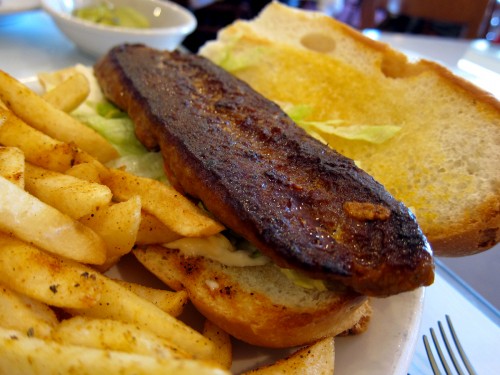Yes indeed, you can get good Louisiana food in Los Angeles, but you have to be careful.
There’s my usual credo (with very few exceptions ever granted), in which I do not patronize a Louisiana restaurant outside of Louisiana unless someone from Louisiana is in the kitchen. Back during the 1980s “Cajun craze” there were a lot of places that switched to or offered menu items labelled as “Cajun” without knowing what the hell they were doing, and putting out a lot of really bad food. Primary among these sinners were the people who thought that Cajun food was regular food encased in red pepper. Then there were those who thought Cajun food came from New Orleans … the litany of offenses goes on and on.
But for years there have been solid, reliable places in L.A., driven by a black Creole community who’ve been out here since the 1940s. Old favorites like Harold and Belle’s (dress up and bring a fat wallet) or Stevie’s Creole Café (former owner of Stevie’s on the Strip, which closed in 2006) in Encino; late, lamented places like Sid’s Cafe (owned by the wonderful Mr. Jase, and almost a second home to me when it was open) and other places that have come and gone.
Apparently, though, another one popped up a couple of years ago, and I didn’t even notice until I got an email from a co-worker which included this appeal:

Click to embiggen
A New Orleans restaurant needed our help? Our help was to go there and eat? Well … I can do that! And so off to New Orleans Vieux Carré Creole Cuisine we went. (4317 Degnan Blvd., LA 90008 in Leimert Park.) The timing couldn’t have been better, either — the day we went was the 5th anniversary of the arrival of Hurricane Katrina in New Orleans, followed by the failure of the Federal levee and floodwall system, and I needed some New Orleans food in me that day.

Spacious, plenty of New Orleans-local decoration and appropriate music, very friendly and welcoming service … I felt right at home. The place was just shy of half-full on a Sunday afternoon, so they can most certainly use the business (although we may have missed out on the after-church crowd).
Let’s get right to business. Iced tea. I figured I didn’t have to do my usual L.A. move of asking whether the tea was real, regular iced tea or some kind of Tropical PassionBerry Explosion kind of abomination. Nope, real southern iced tea — thumbs up. (They kindly offer both unsweetened and “sweet tea,” the latter of which I usually avoid pretty much anywhere.) Next, the test of mettle of a Louisiana restaurant — the gumbo.

Filé gumbo
Dark roux, very flavorful, although a bit salty for me (I tend to be sensitive to it, however). Plenty of seafood (big chunk of blue crab and shrimp), plus smoked and fresh hot sausage. I didn’t need to add any hot sauce to it, either. All in all a fine gumbo.

Crawfish & Corn Chowder
This is what blew me away in the soup category, though. What the menu describes as their “famous” Crawfish and Corn Chowder came next, and it seems to me that whatever fame it has is more than justified. Thick, rich, lots of crawfish (Louisiana crawfish, I was assured), freshly cut corn, beautifully seasoned. Next time I’m getting a whole bowl of this.
Those of you who may know my taste know how much I love New Orleans’ beloved Creole hot sausage, and especially hot sausage po-boys. If I had to choose a last meal, it’d probably be a hot sausage po-boy with fries, and a big plate of red beans ‘n rice. I didn’t order the red beans — I don’t usually order that dish in a restaurant, because I make it at home all the time and because mine is, well … the best (*cough*cough* … okay, I really should try their red beans next time) — but I had to have a hot sausage po-boy, despite the massive amount of food we’d already ordered.

Hot sausage po-boy
My first question — links or patties? Patties are the way to go for me, but NOVC serves theirs with links. That’s fine, of course! It’s just my personal idiosyncracy, and it depends on the type and style of sausage, and these were hot links, perfectly seasoned and nicely grilled with crisp edges. Then there’s the question of the bread … sigh. It’s nearly impossible to get proper New Orleans po-boy bread out here — Vietnamese baguettes come the closest — even though Leidenheimer’s say they ship nationally. The bread was good, but it was the soft variety. Still, a very solid hot sausage po-boy, probably the only one you can get in Los Angeles that I know of, and for that reason it is to be celebrated. (The fries were good too.)
Next came their featured dish of the day:

Shrimp & Crawfish Étouffée
Shrimp and Crawfish Étouffée, loaded with seafood, big fat shrimp and a ton of crawfish, and easily enough food for two people (I took half mine home and had a wonderful leftover dinner the next night). A marvelous dish, and I’ve heard good things about it at this restaurant, but if anything that day it seemed a touch underseasoned. (I added a few sprinkles of Creole seasoning to my leftovers and that really did the trick.) I suspect that this was just an inconsistency of that day, though, given how well everything else was seasoned, and I’d most certainly order it again.

Stuffed Catfish
Wes got the Stuffed Catfish, beautifully fried and seasoned, and stuffed with a seafood and ham dressing. This is exactly the kind of dish I’d expect to get at Mandina’s back home, even down to the little dish of green beans (just like you get at Mandina’s, if you know what I mean. 😉 )
Desserts were offered, but we were more than stuffed. That will have to wait for next time, when we come back in force with the Fat Pack in tow, and tear our way through as much of that menu as we can (entire dishes ordered “for the table,” as we’re fond of saying). I’d prefer to have at least a couple more visits under my belt before writing an actual review, but we were happy enough eating there, and we want to help them enough as well, that I decided not to wait until I had tried more dishes. (Sheesh, it’s already been six weeks, with me being God Emperor of Procrastination and all.)
If you’re looking for very good, relatively inexpensive Creole food in Los Angeles, this is where you need to go, and go often.














